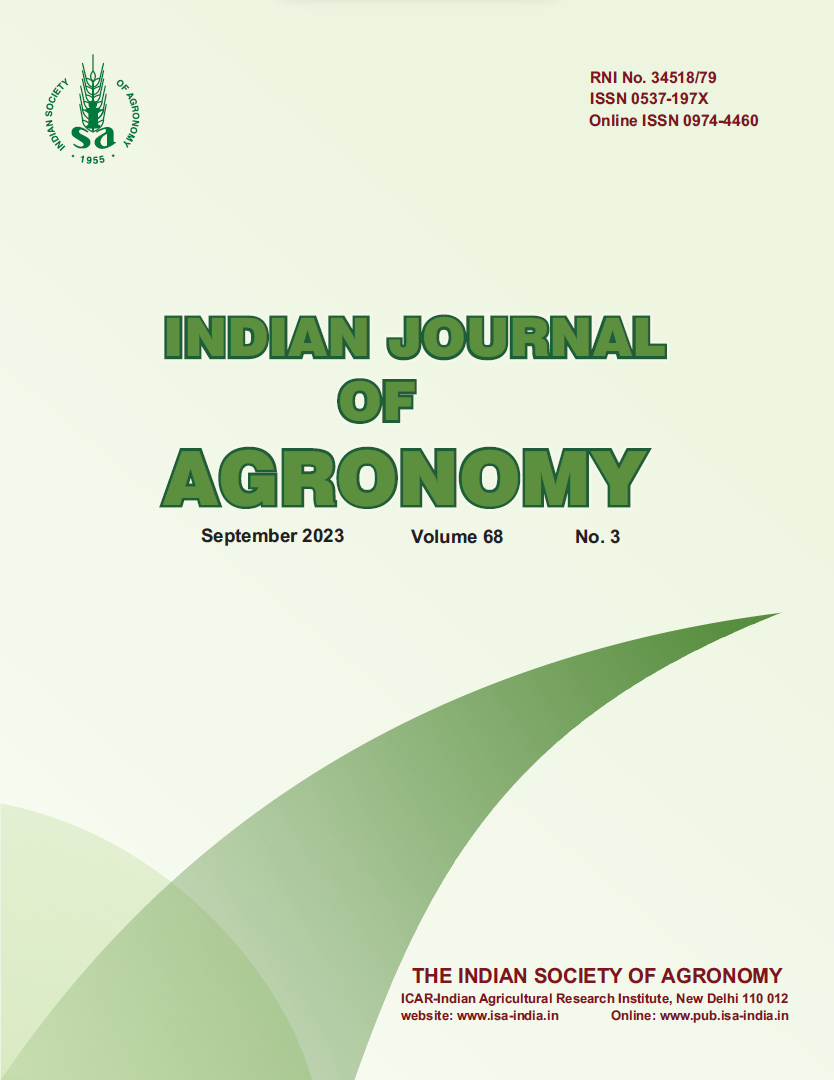Nitrogen, Rhizobium and molybdenum for higher soil bacterial population, N uptake and productivity of lentil (Lens culinaris) grown under rice (Oryza sativa)-fallow conditions
DOI:
https://doi.org/10.59797/ija.v68i3.2810Keywords:
Bacterial population, Benefit: cost ratio, Grain yield, Lentil, N dose, N uptake, Rice-fallows, Rhizobium, Sodium molybdateAbstract
A field experiment was conducted during the winter (rabi) seasons of 2014–15, 2015–16 and 2016–17 in loamy soils of the Regional Agricultural Research Station, Assam Agricultural University, Shillongani, Assam, to study the effect of varying doses of nitrogen, Rhizobium and molybdenum on bacterial population in soil, N uptake, yield attributes, grain yield and economics of lentil (Lens culinaris Medikus spp. culinaris) grown after the harvesting of winter rice (Oryza sativa L.) variety ‘Gitesh’. Soil bacterial population increased with the increase in nitrogen doses. The crop grown using seeds inoculated with Rhizobium @ 50 g/kg seed and sodium molybdate @ 1 g/kg seed along with 100% of recommended dose (RD) of N (15 kg/ha) accrued in the highest bacterial population in the soil at harvesting. Seed inoculation with Rhizobium and sodium molybdate led to considerably higher bacterial population build up in soil than seed inoculation with Rhizobium and sodium molybdate separately. Nitrogen uptake by lentil got reduced with decreasing N doses, being 28.54 kg/ha under RD of N and 28.03 kg/ha under 75% of recommended N. The treatment combinations involving RD and 75% of RD of N (11.25 kg/ha) and seed inoculation with Rhizobium and sodium molybdate recorded 35.16 kg/ha and 34.97 kg/ha N uptake respectively. These 2 treatment combinations ultimately accrued in higher values for plant height, pods/plant, seeds/pod and 100-seed weight and significantly higher grain yield (928.90 and 868.89 kg/ha respectively) as compared to all other treatment combinations. Benefit: cost ratios under these 2 treatment combinations were 2.18 and 2.09 respectively. The treatment combinations were tested for maximizing lentil production utilizing rice-fallows and farmers’ acceptability in farmers’ fields during rabi 2017–18 through 3 Krishi Vigyan Kendras (KVK) in Upper Brahmaputra Valley (UBV) in Jorhat district, Central Brahmaputra Valley (CBV) in Nagaon district and Lower Brahmaputra Valley (LBV) in Nalbari district of the state. The RD of N + seed inoculation with Rhizobium and sodium molybdate yielded the highest (5.8–8.2 q/ha) at all the locations closely followed by 75% RD of N + Rhizobium + sodium molybdate (5.93–7.25 q/ha).
References
Alam, F., Kim, T.Y., Kim, S.Y., Alam, S.S., Pramanick, P., Kim, P.J. and Lee, Y.B. 2015. Effect of molybdenum, on nodulation, plant yield and nitrogen uptake in hairy veteh. Soil Science and Plant Nutrition 61(4): World Congress of Soil Science Special Section.
Ali, M., Ghosh, P.K. and Hazra, K.K. 2014. Resource conservation technologies in rice-fallow. (In) Resource Conservation Technology in Pulses, pp. 83–88. Ghosh, P.K., Kumar, N., Venkatesh, M.S., Hazra, K.K., Nadarajan, N. (Eds). Scientific Publishers, Jodhpur, Rajasthan, India.
Carlos, A.C.C., Ferrari, J., Mui, T.S., Alan, J.F., da costa, C.H.M., Castro, G.S.A., Ribeiro, L.C. and Costa, N.R. 2019. Rhizobial inoculation and molybdenum fertilization in peanut crops grown in a no tillage system after 20 years of pasture. Revista Brasileira de Ciencia do Solo 43 http://dx.doi.org/10.1590/18069657rbcs20170399.
Das, A., Patel, D.P., Ramkrushna, G.I., Munda, G.C., Ngachan, S.V., Buragohain, J., Kumar, M. and Naropongla. 2013. Crop diversification, crop and energy productivity under raised and sunken beds: results from a seven-year study in a high rainfall organic production system. BiolAgricHortic. http://dx.doi.org/10.1080/01448765. 2013. 854709.
Das, A., Ramkrushna, G.I., Patel, D.P., Choudhury, B.U., Munda, G.C., Rajkhowa, D.J. and Ngachan, S.V. 2012. Zero tillage pea, lentil and toria cultivation in rice fallow for diversification and resource conservation in hills. ICAR Research Complex for North-Eastern Hills Region, Umiam, Meghalaya.
Ghosh, P.K., Hazra, K.K., Nath, C.P., Das, A. and Acharya, C.L. 2016. Scope, constraints and challenges for intensifying rice (Oryza sativa)-fallows through pulses. Indian Journal of Agronomy 61(4th IAC special issue): S 122–S 128.
Kabir, M.H., Das, P., Islam, M.M., Hossain, M.B., Islam, M.M, Mamun, A.N.K. and Ronald, V.R. 2019. Effect of different doses of nitrogen-on-nitrogen fixation and yield of lentil using tracer technique. GSC Biological and Pharmaceutical Sciences 6(3): 69–75.
Kolb, W. and Martin, P. 1988. Influence of nitrogen on the number of N2 -fixing and total bacteria in the rhizosphere. Soil Biology and Biochemistry 20: 221–225.
Lal, R. 2013. Enhancing ecosystem service with no-till. Renewable Agriculture and Food Systems 28: 102–114.
Layek, J., Choudhury, S., Ramkrushna, G.I. and Das, A. 2014. Evaluation of different lentil cultivars in lowland rice fallow under no-till system for enhancing cropping intensity and productivity. Indian Journal of Hill Farming 27(2): 4–9.
Liljeroth, E., Schelling, G.C. and Van Veen, J.A. 1990. Influence of different application rates of nitrogen to soil on rhizosphere bacteria. Netherlands Journal of Agricultural Science 38(1990): 255–264.
Pande, S., Sharma, M. and Ghosh, R. 2012. Role of pulses in sustaining agricultural productivity in the rainfed rice-fallow lands of India in changing climatic scenario. (In) Climate Change and Food Security in India: Proceedings of National Symposium on Food Security in Context of Changing Climate, 30 October to 1 November, held at CSAUAT, Kanpur, Uttar Pradesh, India, pp. 53–70.
Pramer, D. and Schmidt, E.D. 1966. Experimental Soil Microbiology, pp. 106. Burges Publishing Co., Minneapolis, MN, USA,.
Rahman, M.M., Bhuiyan, M.M.H., Sutradhar, G.N.C., Rahman, M.M. and Paul, A.K. 2008. Effect of phosphorus, molybdenum and Rhizobium inoculation on yield and yield attributes of mungbean. International Journal of Sustainable Crop Production 3(6): 26–33.
Singh, S.S., Kumar, N., Praharaj, C.S. and Singh, N.P. 2017. Agrotechnologies for pulses in rice-fallows. ICAR-Indian Institute of Pulses Research, Kanpur, Uttar Pradesh, India.
Strachel, R., Wyszkowska, J. and Bacmaga, M. 2017. The influence of nitrogen on the biological properties of soil contaminated with Zinc. Bulletin of Environmental Contamination and Toxicology 98(3): 426–432.
Swarnalakshmi, K., Yadav, V., Senthilkumar, M. and Dhar, D.W. 2016. Biofertilizers for higher pulse production in India: Scope, accessibility and Challenges. Indian Journal of Agronomy 61(4th IAC special issue): S 173–S 181.
Zhou, J. and Jiang, Xin. 2017. Consistent effects of nitrogen fertilization on soil bacterial communities in black soils for 2 crop seasons in China. Scientific Reports 7, Article number: 3,267.






